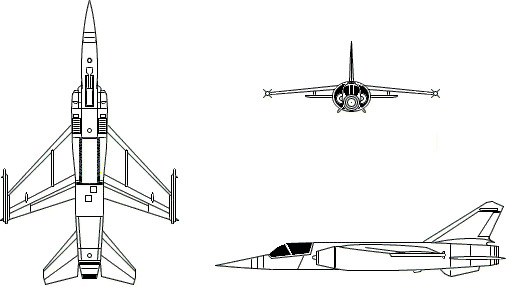Mirage F1
Summary
| Category | Combat Aircraft |
| Origin country | 🇫🇷 France |
| Manufacturer | Dassault |
| First flight | 23 December 1966 |
| Year introduced | 1973 |
| Number produced | 726 units |
| Average unit price | $8 million |
Description
The Mirage F1 emerged from a series of design studies by Dassault Aviation. Initially considering a larger swept wing derivative of the Mirage III, which became the Mirage F2, parallel studies led to the development of a smaller derivative intended as an interceptor, the Mirage F3, and a single-seat version powered by the SNECma Atar 9K-50 turbojet engine. With reduced workload, Dassault initiated design work on the single-seat Mirage F1 in mid-1964, envisioning it as a successor to the Mirage III and 5 and aligning with a potential French Air Force specification for an all-weather interceptor. On December 23, 1966, the first prototype took flight, reaching Mach 2 during its fourth flight. The French Air Force officially adopted the Mirage F1 program in late 1966. Following a redesign after the loss of the first prototype on May 18, 1967, a second prototype flew on March 20, 1967, and an order for three prototypes was placed on May 26, 1967. By late 1971, production of an initial batch of 85 Mirage F1s was authorized. The first production Mirage F1C, equipped with a Thomson-CSF Cyrano IV radar, was delivered to the French Air Force in May 1973 and entered squadron service in December of that year. By October 1971, production was underway at Dassault's Bordeaux facility and SABCA's plant in Belgium. The 79 aircraft of the subsequent production run, the Mirage F1C-200 variant, were delivered between March 1977 and December 1983, featuring a fixed refuelling probe and a fuselage extension.
The Dassault Mirage F1 is a single-engine fighter aircraft designed for interception and ground attack roles. It utilizes a shoulder-mounted swept wing instead of a delta wing, resulting in shorter runway requirements and increased internal fuel capacity compared to its predecessors. Key advancements include its onboard avionics, featuring the Thomson-CSF Cyrano IV monopulse radar system, offering air-target acquisition, ground mapping, and terrain avoidance modes. Later models offered limited look-down capability and increased detection range. Standard production models include an Instrument Landing System (ILS), radar altimeter, UHF/VHF radio sets, Tactical Air Navigation system (TACAN), a ground data link, autopilot, and yaw damper. The aircraft is powered by a single SNECma Atar 9K-50 turbojet engine, providing approximately 7 tonnes-force of thrust. This propulsion system enables a maximum speed of 1,453 MPH and a ceiling of 65,615 feet.
The initial armament of the Mirage F1 consisted of two internal 30 mm DEFA 553 cannons, each with 150 rounds. Early interceptor configurations included a single Matra R530 medium-range air-to-air missile carried under the fuselage. The aircraft was designed to carry a combined external payload of up to 6,300 kg (13,900 lb) on one centerline pylon, four underwing pylons, and two wingtip pylons; however, the practical maximum load was around 4,000 kg (8,800 lb). After 1979, the R530 was superseded by the Matra Super 530F missile. The aircraft could carry the R550 Magic missile on wingtip rails, and the American AIM-9 Sidewinder was integrated for some export operators. For ground attack missions, the Mirage F1 could carry various types of bombs, cluster munitions, rockets (including Matra rocket pods with 18 SNEB 68 mm rockets each), and AS-30L laser-guided missiles. It could also be equipped with reconnaissance pods or drop tanks.
The Mirage F1 has seen extensive operational use. French Air Force Mirage F1s were deployed in Operation Manta in Chad in 1984, providing air cover and engaging in skirmishes. Further deployments occurred in 1986 as part of Operation Epervier, supporting air raids. During the Persian Gulf War, French Mirage F1s were stationed in Qatar and Saudi Arabia, initially conducting reconnaissance and serving in the fighter bomber role. Ecuadorian Mirage F1JAs engaged in combat air patrols during the Paquisha War in 1981 and were upgraded for the Cenepa War in 1995, claiming downings of Peruvian aircraft. The Hellenic Air Force utilized Mirage F1CGs, while Iraqi Mirage F1EQs saw intensive action during the Iran–Iraq War, performing interception, ground attack, and anti-shipping missions. Moroccan Mirage F1s were deployed in the Western Sahara War from 1979 onward. South African Mirage F1CZ and F1AZ variants saw considerable combat during the Border War, engaging in air-to-air combat and ground attack operations.
Main Variants:
-
Mirage F1A: A single-seat ground-attack fighter aircraft with a lightweight EMD AIDA 2 ranging radar, a laser rangefinder, a retractable refuelling probe, and increased fuel capacity.
-
Mirage F1B: A two-seat operational conversion trainer retaining combat capability but sacrificing internal fuel capacity and internal cannons.
-
Mirage F1C: The initial production interceptor version for the French Air Force, equipped with the Thomson-CSF Cyrano IV radar.
-
Mirage F1CR: A tactical reconnaissance version carrying internal and external reconnaissance equipment.
-
Mirage F1CT: An upgraded ground attack version of the F1C-200 for the French Air Force, with enhanced avionics for air-to-ground missions while retaining air-to-air capabilities.
Technical specifications
| Version: Mirage F1E-M53 | |
|---|---|
| Crew | 1 pilot |
| Operational range | 1,600 km (994 mi) |
| Maximum speed | 2350 km/h (1460 mph) |
| Wing area | 25 m² (269.1 sqft) |
| Wingspan | 8.5 m (27.7 ft) |
| Height | 4.6 m (15.0 ft) |
| Length | 15.5 m (51.0 ft) |
| Service ceiling | 20,000 m (65,617 ft) |
| Empty weight | 8,024 kg (17,690 lbs) |
| Max. takeoff weight | 15,200 kg (33,510 lbs) |
| Climb rate | 242.0 m/s (794.0 ft/s) |
| Powerplant | 1 x turbojet SNECMA M53 delivering 5550 kgf each |
All operators






